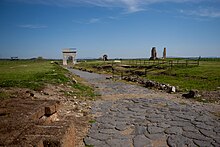
Back Volci ALS Вульчы Byelorussian Вулци Bulgarian Volci Catalan Vulci Czech Vulci German Vulci Spanish Vulci Finnish Vulci French Velch Hungarian
 The archaeological site of Vulci | |
| Alternative name | Volci, Velch, Velx |
|---|---|
| Location | Montalto di Castro, Province of Viterbo, Lazio, Italy |
| Region | Latium |
| Coordinates | 42°25′08″N 11°37′54″E / 42.41889°N 11.63167°E |
| Type | Settlement |
| Site notes | |
| Ownership | Public |
| Management | Soprintendenza per i Beni Archeologici dell'Etruria Meridionale |
| Public access | Yes |
| Website | Vulci Archaeological Naturalistic Park(in Italian)-(in English) |
Vulci or Volci [pronunciation?] (Etruscan: Velch or Velx, depending on the romanization used) was a rich Etruscan city in what is now northern Lazio, central Italy.
As George Dennis wrote, "Vulci is a city whose very name ... was scarcely remembered, but which now, for the enormous treasures of antiquity it has yielded, is exalted above every other city of the ancient world."[1]
Vulci was located near the coast of the Tyrrhenian Sea about 80 km northwest of Rome, on the Fiora River, between Montalto di Castro and Canino. Remains of the city can be seen today.
The Vulci, like other Etruscans, became master sculptors in bronze as acknowledged by ancient writers.[2][3] Although most large bronzes have been lost, there remain some magnificent examples of Etruscan bronze work such as the Chimera of Arezzo and the Monteleone chariot, possibly made in Vulci.[4]
In the 19th century thousands of the ancient tombs of Vulci were discovered, and many were so well known and spectacular, such as the Tomb of the Sun and Moon, that they were included on the Grand Tour of Europe. From these tombs more Attic vases have been found in the Vulci tombs than at any other ancient site[5] (at least by the 1850s) and many of these masterpieces as well as Etruscan bronzes have found their way into the major museums of the world where they can be seen today.
Despite these discoveries most of these tombs were later forgotten and lost.
- ^ Dennis, George (1848). The Cities and Cemeteries of Etruria. London.
- ^ Athenaeus Deipnosophists 1.28b
- ^ Vitruvius iii.3.5 Pliny Natural History 16
- ^ "Bronze chariot inlaid with ivory - Work of Art - Heilbrunn Timeline of Art History - The Metropolitan Museum of Art". The Met’s Heilbrunn Timeline of Art History.
- ^ The Cities and Cemeteries of Etruria, Chapter XXI Vulci, George Dennis, 1848.

